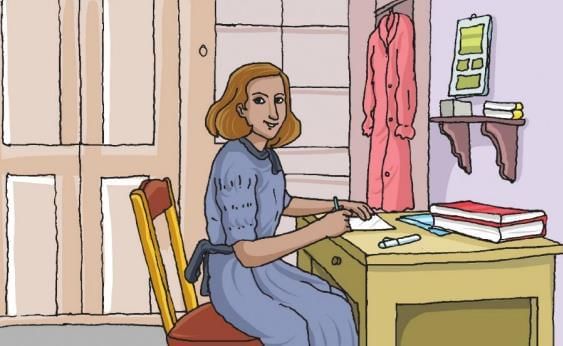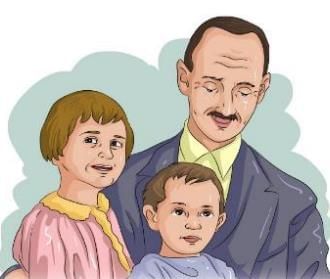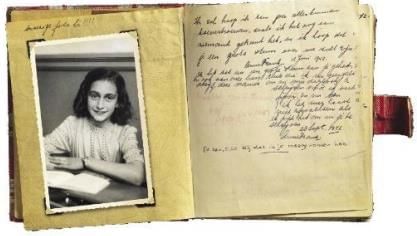The Diary of a Young Girl Chapter Notes | English Class 6 ICSE PDF Download
| Table of contents |

|
| Introduction |

|
| Key Points |

|
| Explanation |

|
| Message |

|
Introduction
The Diary of a Young Girl is about Anne Frank, a Jewish girl who started writing her diary on her thirteenth birthday, June 12, 1942. She got the diary as a gift and named it Kitty, treating it like her best friend. Anne wrote about her daily life, her feelings, and her hopes during World War II, when Jews were treated very badly by Adolf Hitler and the Nazis. Her diary shows her courage and positive spirit, even in very difficult times.

Key Points
This story is about Anne Frank, a thirteen-year-old girl who got a diary for her birthday on June 12, 1942, and started writing her thoughts in it.
- She lived during World War II when Adolf Hitler and the Nazis were in power in Germany, starting from 1933, and treated Jews harshly.
- Anne felt lonely even though she had a loving family and many friends, so she named her diary Kitty and treated it like a close friend.
- Her family moved from Germany to Holland in 1933 to escape Nazi persecution, but life got harder after Germany invaded Holland in 1940.
- Jews faced strict rules, like wearing yellow stars, staying indoors at night, and not being allowed to use bikes or go to movies.
- Anne wrote about her school life, including how her math teacher, Mr. Keesing, gave her essays as punishment for talking too much in class.
- In July 1942, her sister Margot got a notice to go to a labor camp, so the family went into hiding in a Secret Annexe in Otto Frank’s office building.
- The van Daan family and Mr. Dussel joined them in hiding, living in a small space with little food and constant fear of being caught.
- Anne wrote about her mixed feelings in hiding—sometimes hopeful, sometimes scared—especially after events like a break-in at the building.
- On August 4, 1944, the German police found their hiding place, arrested them, and sent them to concentration camps; Anne died in 1945.
- Otto Frank, the only survivor, found Anne’s diaries after the war and published them, making her story famous around the world.
Explanation
Anne’s Early Years and Background
Anne Frank was a Jewish girl born in Frankfurt, Germany. In 1933, when she was four, her family moved to Holland because Adolf Hitler and his Nazi party were making life dangerous for Jews in Germany. The Nazis took away Jewish people’s homes, jobs, and rights, planning to harm them further. Anne’s father, Otto Frank, moved first, and her mother, Edith, followed. Anne and her older sister, Margot, stayed with their grandmother in Aachen for a while before joining their parents in Holland.

In February 1934, Anne arrived as a surprise birthday gift for Margot. They lived a normal life until 1940 when Germany invaded Holland, and new rules made life tough for Jews. Anne’s grandmother moved in with them but got sick in 1941, had an operation, and died in January 1942, which made Anne very sad.
Starting the Diary and School Life
On June 20, 1942, Anne began writing in her diary, which she got as a birthday gift on June 12. She felt lonely, even with her parents, sister, and about thirty friends, because she didn’t have a true friend to share her deepest thoughts with. She named her diary Kitty, imagining it as her best friend. In her entries, she wrote about her life, starting with her move from Germany to Holland.

At school, Anne was talkative, which annoyed her math teacher, Mr. Keesing. He called her a “chatterbox” and gave her an essay to write about it as punishment. Anne cleverly wrote that talking was a trait she got from her mother and couldn’t fully stop.
Mr. Keesing found it funny but gave her another essay, “An Incorrigible Chatterbox,” when she kept talking. After a third essay, “Quack, Quack, Quack,” Anne, with help from her friend Sanne, wrote a funny poem about ducklings that made Mr. Keesing laugh. He read it to the class and stopped punishing her, even making jokes himself.
Life Under Nazi Restrictions
After Germany took over Holland in May 1940, Jews faced many strict rules. They had to wear a yellow star to show they were Jewish, shop only between 3 and 5 P.M., and stay indoors from 8 P.M. to 6 A.M. They couldn’t ride bikes, use cars, or go to places like theaters, swimming pools, or sports fields.
Jews also had to attend separate schools and couldn’t visit non-Jewish homes. These rules made life hard, but Anne wrote that they tried to keep going. She also mentioned the 1938 pogroms, where Jews in Germany were attacked, and her uncles fled to North America for safety.
Going into Hiding
On July 5, 1942, Margot, who was sixteen, got a call-up notice, meaning she might be sent to a labor camp where conditions were terrible. To protect her, the Frank family went into hiding the next day. They wore many layers of clothes to avoid carrying suitcases, which could look suspicious. Otto had secretly set up a hiding place, called the Secret Annexe, in his office building in Amsterdam.
Margot was taken there separately by a friend on a bicycle. A few days later, the van Daan family—Mr. and Mrs. van Daan and their son Peter—joined them. In November, Mr. Dussel, a dentist and family friend, also came. The group lived in a small, cramped space, depending on Otto’s friends, like Mr. Kugler, for food and supplies. They had to be quiet and careful to avoid being caught.
Life in the Secret Annexe
For two years, from July 1942 to August 1944, Anne and the others lived in the Secret Annexe, facing many challenges. Anne’s diary entries, like one from May 26, 1944, describe the ups and downs of their life. They sometimes enjoyed small moments, like celebrating birthdays with cakes, but often felt scared and tense.

A break-in at the building made Anne feel unsafe, especially when alone downstairs, hearing strange noises. Food was scarce, and news about the war, like the delayed Allied invasion, added to their worries. Anne wrote about her fear of being caught and her hope for freedom, even wondering if hiding was worth the misery. Despite the fear, she loved life and kept hoping for better days.
Arrest and Legacy
On August 4, 1944, the German police, likely tipped off by an informer, raided the Secret Annexe and arrested everyone. They were sent to concentration camps. Anne and Margot were sent to Bergen-Belsen, where Anne died in early 1945 from illness and malnutrition, just weeks before the camp was liberated by the British.
Otto Frank was the only survivor. After the war, he found Anne’s diaries in the Annexe and published them. Her words, full of hope, courage, and honesty, have inspired people worldwide, making her diary a famous and powerful book.
Message
The chapter teaches us to stay hopeful and brave, even when life is tough. Anne’s diary shows how writing can help express feelings and keep dreams alive. It also reminds us to value freedom and learn from the pain caused by hatred and war.
New Words with Meanings
- Confiscating: Taking someone’s property as a punishment.
- Brooding: Thinking deeply about something sad.
- Stiff-backed: Having a hard cover, like a book.
- Pogrom: An organized attack on a group because of their race or religion.
- Capitulation: Surrendering, like the Dutch did to Germany.
- Decree: An official order that acts as a law.
- Quaking: Feeling nervous or scared.
- Dummy: A person who seems not very smart.
- Fogey: Someone who is boring or old-fashioned.
- Incorrigible: Unable to be corrected.
- Roared: Bursting into loud laughter.
- Ingenuity: The ability to create something new and smart.
- Vanquished: The side that loses in a fight.
- Resonates: Continues to have a strong effect.
|
38 docs|19 tests
|
FAQs on The Diary of a Young Girl Chapter Notes - English Class 6 ICSE
| 1. What is the significance of "The Diary of a Young Girl" in understanding the Holocaust? |  |
| 2. How does Anne Frank's writing style contribute to the themes in her diary? |  |
| 3. What are some key themes explored in "The Diary of a Young Girl"? |  |
| 4. How did Anne Frank's diary come to be published? |  |
| 5. In what ways has "The Diary of a Young Girl" influenced modern literature and education? |  |














